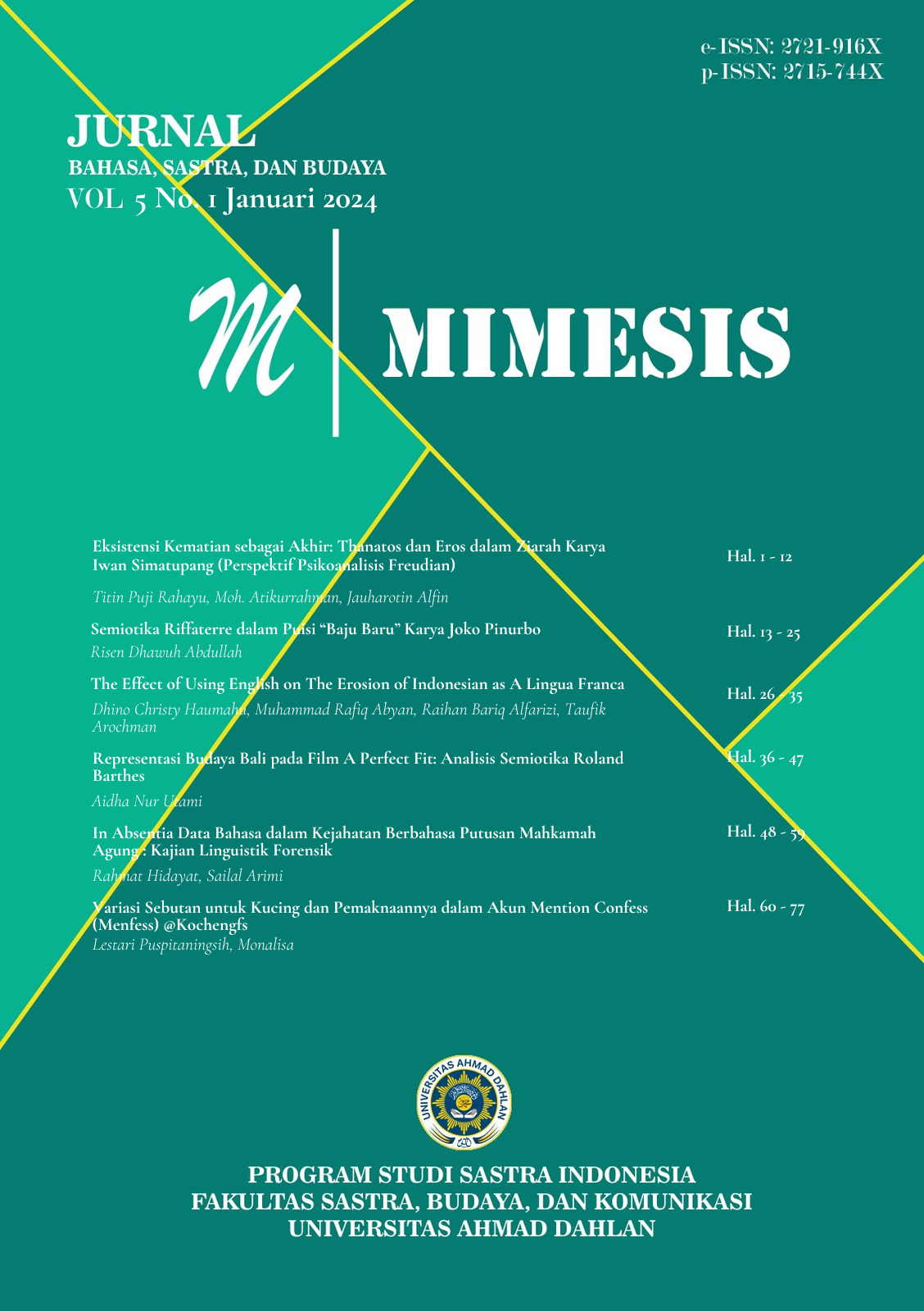In Absentia Data Bahasa dalam Kejahatan Berbahasa Putusan Mahkamah Agung: Kajian Linguistik Forensik
DOI:
https://doi.org/10.12928/mms.v5i1.9579Keywords:
Forensic Linguistics, High Court Verdict, In Absentia, Language Crime, SemanticsAbstract
Violation of language norms committed by an individual can result in sanctions or punishment. The penalties imposed in cases of hate speech may include fines or imprisonment. In the case of Bahar bin Smith and Yulianus Paonganan, there were language violations, particularly in the form of insults, defamation, and tarnishing the reputation of President Joko Widodo. Bahar bin Smith was sentenced to six months and fifteen days, while Yulianus Paonganan was sentenced to one year of imprisonment. Interestingly, in the Supreme Court’s decision regarding Bahar bin Smith’s case, there is no information regarding language violations. This raises questions about how a punishment for language-related crimes can be decided without linguistic evidence. This research is descriptive and qualitative, using a semantic approach to identify forms of hate speech. The linguistic forensic research results highlight the forms, types, and grammatical meanings of hate speech. Furthermore, the research findings indicate that the Supreme Court, in issuing decisions, is not always professional, lacks transparency, and exhibits negligence and carelessness, as evidenced by the issuance of a verdict without linguistic violation evidence.
References
Abdulsyani, A. (1987). Sosiologi Kriminalitas Remadja. Karya CV.
Anantama, A. T., Munawir, Z., & Rafiqi, R. (2020). Pertanggung Jawaban Pidana Karyawan Korporasi Dalam Tindak Pidana Lingkungan Hidup (Studi Putusan No. 133/Pid.B/2013/PN. MBO). JUNCTO: Jurnal Ilmiah Hukum, 2(2), 119–131. https://doi.org/10.31289/juncto.v2i2.322
Ardhianti, M., Prawoto, E. C., Pujiastuti, R., & Risaldi, A. (2023). Semiotika Kritis Pendekatan dalam Teks Kejahatan Siber. PT Pena Persada Kerta Utama.
Baihaqi, B., & Tisa, M. (2018). Waria Dan Resiliensi Terhadap Penolakan Masyarakat. AT-TANZIR: Jurnal Ilmiah Prodi Komunikasi Penyiaran Islam, 9–24.
Deramayati, T. Y., & Wicaksana, S. U. (2021). Peradilan In Absentia Dalam Tindak Pidana Korupsi dan Hak Pembelaan Terdakwa dalam Perspektif HAM. 7(2), 570–591.
Detiknews, D. (2018). Ini Transkrip Habib Bahar bin Smith Sebut Jokowi Kayaknya Banci. https://news.detik.com/berita/d-4322637/ini-transkrip-habib-bahar-bin-smith-sebut-jokowi-kayaknya-banci
Dewi, C. I. D. L. (2021). Aspek Hukum Kebebasan Berpendapat dan Berekspresi. Jurnal Yustitia, 15(1).
Foley, W. A. (1993). The Role of Theory in Language Description. Mouton de Gruyter.
Fuady, M., & Laura, S. (2015). Hak Asasi Tersangka Pidana. Predana Media Group.
Keraf, A. S. (2010). Etika Lingkungan Hidup. Kompas.
Kusno, A., Arifin, M. B., & Mulawarman, W. G. (2022). Pengungkapan Muatan Ujaran Kebencian Berdasarkan Kesukuan Pada Bahasa Sebagai Alat Bukti Hukum: Analisis Linguistik Forensik (Disclosure of Hate Speaking Based on Ethnicity on Language as Legal Evidence: Forensic Linguistic Analysis). JURNAL BAHASA, SASTRA, DAN PEMBELAJARANNYA, 12(2), Article 2. https://doi.org/10.20527/jbsp.v12i2.12721
McMenamin, M. (2022). Forensic Linguistics: Advances in Forensic Stylistics—1st Edition -. CRC Press. https://doi.org/10.1201/9781420041170
Ningrum, D. J., Suryadi, S., & Chandra Wardhana, D. E. (2018). KAJIAN UJARAN KEBENCIAN DI MEDIA SOSIAL. Jurnal Ilmiah KORPUS, 2(3), 241–252. https://doi.org/10.33369/jik.v2i3.6779
Noviasari, D. T. (2022). Keadilan Gender di Tengah Perkembangan Politik Global dalam Perspektif Hak Asasi Manusia. Borobudur Law and Society Journal, 1(4), 24–32. https://doi.org/10.31603/8358
Rizky, V. S., & Dianti, F. (2022). Pertanggungjawaban Notaris SA Dalam Membuat Surat Keterangan Waris Berdasarkan Keteranagan Palsu. 6(3), 9911–9924. http://dx.doi.org/10.58258/jisip.v6i3.3298
Salsabilla, R., & Arimi, S. (2023). Umpatan sebagai Penanda Relasi Keakraban Antar Mahasiswa: Analisis Berbasis Bentuk dan Gender. MIMESIS, 4(2), 202–219. https://doi.org/10.12928/mms.v4i2.8367
Sari, S. W. (2017). Mediasi Dalam Peraturan Mahkamah Agung Nomor 1 Tahun 2016. Ahkam: Jurnal Hukum Islam, 5(1), 1–16. https://doi.org/10.21274/ahkam.2017.5.1.1-16
Sit, M. (2012). Perkembangan Peserta Didik. Perdana Publishing.
Stephen, U. (2012). Pengantar Semantik. Pustaka Pelajar.
Suhariyanto, B. (2016). Masalah Eksekutabilitas Putusan Mahkamah Konstitusi Oleh Mahkamah Agung. Jurnal Konstitusi, 13(1).
Thamrin, H., Bachari, A. D., & Rusmana, E. (n.d.). Tindak Tutur Kebencian di Media Sosial Berkaitan Delik Hukum Pidana (Kajian Linguistik Forensik). 423–432.
Warami, H. (2021). Kejahatan Bahasa di Media Sosial Pada Wilayah Hukum Manokwari: Kajian Linguistik Forensik. CC, 2(1), 19–26.
Warong, K. M., Waha, C. J. J., & Tangkere, C. (2020). Kajian Hukum Hak Asasi Manusia Terhadap Kebebasan Berpendapat Oleh Organisasi Kemasyarakatan di Media Sosial. 8(5), 44–53.
Wijana, I., Dewa Putu, & Rohmadi, M. (2006). Sosiolinguistik Kajian Teori dan Analisis. Pustaka Pelajar.
Downloads
Published
Issue
Section
License
Copyright (c) 2024 Rahmat Hidayat, Sailal Arimi

This work is licensed under a Creative Commons Attribution-ShareAlike 4.0 International License.
License and Copyright Agreement
In submitting the manuscript to the journal, the authors certify that:
- They are authorized by their co-authors to enter into these arrangements.
- The work described has not been formally published before, except in the form of an abstract or as part of a published lecture, review, thesis, or overlay journal.
- That it is not under consideration for publication elsewhere,
- That its publication has been approved by all the author(s) and by the responsible authorities tacitly or explicitly of the institutes where the work has been carried out.
- They secure the right to reproduce any material that has already been published or copyrighted elsewhere.
- They agree to the following license and copyright agreement.
Copyright
Authors who publish with Mimesis agree to the following terms:
- Authors retain copyright and grant the journal right of first publication with the work simultaneously licensed under a Creative Commons Attribution License (CC BY-SA 4.0) that allows others to share the work with an acknowledgment of the work's authorship and initial publication in this journal.
- Authors are able to enter into separate, additional contractual arrangements for the non-exclusive distribution of the journal's published version of the work (e.g., post it to an institutional repository or publish it in a book), with an acknowledgment of its initial publication in this journal.
- Authors are permitted and encouraged to post their work online (e.g., in institutional repositories or on their website) prior to and during the submission process, as it can lead to productive exchanges, as well as earlier and greater citation of published work.











